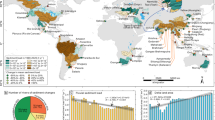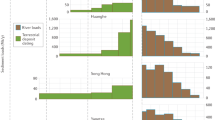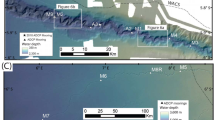Abstract
Fluvial sediment transport, a key pathway for global biogeochemical cycling, has changed markedly in the Anthropocene. However, disaggregating the compound effects of anthropogenic stresses on fluvial sediment transport at the global scale remains a challenge. Here we map the suspended sediment concentrations for global river channels, based on satellite observations, between 1985 and 2020, and estimate long-term changes in land–ocean sediment transfer. We find significant (P < 0.05) changes in suspended sediment concentrations in 67.8% (3.2 × 105 km) of the examined river channel length, with 43.4% (2.05 × 105 km) displaying a significant increasing trend, driven mainly by rising rainfall erosion and climate warming. Consequently, a global net increase (+0.58 Gt year−1) in land–ocean sediment flux has been observed over the past four decades, despite sediment trapping by recently constructed dams, mostly in Asia. Our study provides a new baseline for source-to-sink fluvial transport in the Anthropocene that can inform global water resource management and delta management and protection.
This is a preview of subscription content, access via your institution
Access options
Access Nature and 54 other Nature Portfolio journals
Get Nature+, our best-value online-access subscription
27,99 € / 30 days
cancel any time
Subscribe to this journal
Receive 12 digital issues and online access to articles
118,99 € per year
only 9,92 € per issue
Buy this article
- Purchase on SpringerLink
- Instant access to full article PDF
Prices may be subject to local taxes which are calculated during checkout



Similar content being viewed by others
Data availability
The satellite-based dataset of global fluvial SSCs (GSED) is available via figshare at https://figshare.com/s/dde3bffd8e12227e2b26 (ref. 62). The field river SSCs can be accessed at https://gemstat.bafg.de/applications/, https://doi.org/10.5066/P9AEWTB9, https://www.mrcmekong.org/, https://hybam.obs-mip.fr and https://www.canada.ca/en/services/environment.html. The GRWL dataset is available via Zenodo at https://doi.org/10.5281/zenodo.1269594 (ref. 63). Source data are provided with this paper.
Code availability
The MATLAB code developed for the river SSC retrieval and statistics is available via figshare at https://figshare.com/s/dde3bffd8e12227e2b26 (ref. 62). The code for the BEAST algorithm is available at https://github.com/zhaokg/Rbeast.
Change history
27 January 2025
A Correction to this paper has been published: https://doi.org/10.1038/s41893-025-01518-8
References
Walling, D. E. & Fang, D. Recent trends in the suspended sediment loads of the world’s rivers. Glob. Planet. Change 39, 111–126 (2003).
Battin, T. J. et al. River ecosystem metabolism and carbon biogeochemistry in a changing world. Nature 613, 449–459 (2023).
Hauer, C. et al. in Riverine Ecosystem Management: Science for Governing Towards a Sustainable Future (eds Schmutz, S. & Sendzimir, J.) 151–169 (Springer Open, 2018).
Nienhuis, J. H. et al. Global-scale human impact on delta morphology has led to net land area gain. Nature 577, 514–518 (2020).
Syvitski, J. et al. Earth’s sediment cycle during the Anthropocene. Nat. Rev. Earth Environ. 3, 179–196 (2022).
Moragoda, N. & Cohen, S. Climate-induced trends in global riverine water discharge and suspended sediment dynamics in the 21st century. Glob. Planet. Change 191, 103199 (2020).
Syvitski, J. P. M., Vörösmarty, C. J., Kettner, A. J. & Green, P. Impact of humans on the flux of terrestrial sediment to the global coastal ocean. Science 308, 376–380 (2005).
Zhang, T. et al. Warming-driven erosion and sediment transport in cold regions. Nat. Rev. Earth Environ. 3, 832–851 (2022).
Overeem, I. et al. Substantial export of suspended sediment to the global oceans from glacial erosion in Greenland. Nat. Geosci. 10, 859–863 (2017).
Li, D. et al. Exceptional increases in fluvial sediment fluxes in a warmer and wetter High Mountain Asia. Science 374, 599–603 (2021).
Clark, K. E. et al. Extreme rainstorms drive exceptional organic carbon export from forested humid-tropical rivers in Puerto Rico. Nat. Commun. 13, 2058 (2022).
Restrepo, J. D., Kettner, A. J. & Syvitski, J. P. M. Recent deforestation causes rapid increase in river sediment load in the Colombian Andes. Anthropocene 10, 13–28 (2015).
Narayanan, A., Cohen, S. & Gardner, J. R. Riverine sediment response to deforestation in the Amazon basin. Earth Surf. Dyn. 12, 581–599 (2024).
Cohen, S. et al. Spatial trends and drivers of bedload and suspended sediment fluxes in global rivers. Water Resour. Res. 58, e2021WR031583 (2022).
Li, L. et al. Global trends in water and sediment fluxes of the world’s large rivers. Sci. Bull. 65, 62–69 (2020).
Kettner, A. J. & Syvitski, J. P. M. HydroTrend v.3.0: a climate-driven hydrological transport model that simulates discharge and sediment load leaving a river system. Comput. Geosci. 34, 1170–1183 (2008).
Syvitski, J. P. M. Supply and flux of sediment along hydrological pathways: research for the 21st century. Glob. Planet. Change 39, 1–11 (2003).
Feng, D. et al. Recent changes to Arctic river discharge. Nat. Commun. 12, 6917 (2021).
Warrick, J. & Milliman, J. D. Do we know how much fluvial sediment reaches the sea? Decreased river monitoring of US coastal rivers. Hydrol. Process. 32, 3561–3567 (2018).
Park, E. Characterizing channel-floodplain connectivity using satellite altimetry: mechanism, hydrogeomorphic control, and sediment budget. Remote Sens. Environ. 243, 111783 (2020).
Dethier, E. N., Renshaw, C. E. & Magilligan, F. J. Rapid changes to global river suspended sediment flux by humans. Science 376, 1447–1452 (2022).
Syvitski, J. P. M., Peckham, S. D., Hilberman, R. & Mulder, T. Predicting the terrestrial flux of sediment to the global ocean: a planetary perspective. Sediment. Geol. 162, 5–24 (2003).
Yan, D. et al. A data set of global river networks and corresponding water resources zones divisions. Sci. Data 6, 219 (2019).
Deal, E. et al. Grain shape effects in bed load sediment transport. Nature 613, 298–302 (2023).
Wang, S. et al. Reduced sediment transport in the Yellow River due to anthropogenic changes. Nat. Geosci. 9, 38–41 (2016).
Yang, S. L. et al. Downstream sedimentary and geomorphic impacts of the Three Gorges Dam on the Yangtze River. Earth Sci. Rev. 138, 469–486 (2014).
Binh, D. V., Kantoush, S. & Sumi, T. Changes to long-term discharge and sediment loads in the Vietnamese Mekong Delta caused by upstream dams. Geomorphology 353, 107011 (2020).
Vörösmarty, C. J. et al. Anthropogenic sediment retention: major global impact from registered river impoundments. Glob. Planet. Change 39, 169–190 (2003).
Walling, D. & Webb, B. Erosion and sediment yield: a global overview. In Proc. International Association of Hydrological Sciences 3–20 (IAHS, 1996).
Borrelli, P. et al. An assessment of the global impact of 21st century land use change on soil erosion. Nat. Commun. 8, 2013 (2017).
Zhang, W., Zhou, T. & Zhang, L. Wetting and greening Tibetan Plateau in early summer in recent decades. J. Geophys. Res. Atmos. 122, 5808–5822 (2017).
Myers-Smith, I. H. et al. Complexity revealed in the greening of the Arctic. Nat. Clim. Change 10, 106–117 (2020).
Guan, Q. et al. Trends in river total suspended sediments driven by dams and soil erosion: a comparison between the Yangtze and Mekong rivers. Water Resour. Res. 58, e2022WR031979 (2022).
Dethier, E. N., Renshaw, C. E. & Magilligan, F. J. Toward improved accuracy of remote sensing approaches for quantifying suspended sediment: implications for suspended-sediment monitoring. J. Geophys. Res. Earth Surf. 125, e2019JF005033 (2020).
Syvitski, J. P. M. Sediment discharge variability in Arctic rivers: implications for a warmer future. Polar Res. 21, 323–330 (2002).
Bintanja, R. The impact of Arctic warming on increased rainfall. Sci. Rep. 8, 16001 (2018).
Dethier, E. N., Sartain, S. L. & Lutz, D. A. Heightened levels and seasonal inversion of riverine suspended sediment in a tropical biodiversity hot spot due to artisanal gold mining. Proc. Natl Acad. Sci. USA 116, 23936–23941 (2019).
Fagundes, H. O. et al. Human-induced changes in South American river sediment fluxes from 1984 to 2019. Water Resour. Res. 59, e2023WR034519 (2023).
Bourgoin, L. M. et al. Temporal dynamics of water and sediment exchanges between the Curuaí floodplain and the Amazon River, Brazil. J. Hydrol. 335, 140–156 (2007).
Li, T., Wang, S., Liu, Y., Fu, B. & Gao, D. Reversal of the sediment load increase in the Amazon basin influenced by divergent trends of sediment transport from the Solimões and Madeira Rivers. CATENA 195, 104804 (2020).
Karimaee Tabarestani, M. & Zarrati, A. R. Sediment transport during flood event: a review. Int. J. Environ. Sci. Technol. 12, 775–788 (2015).
Syvitski, J. P. M. et al. Sinking deltas due to human activities. Nat. Geosci. 2, 681–686 (2009).
Galy, V., Peucker-Ehrenbrink, B. & Eglinton, T. Global carbon export from the terrestrial biosphere controlled by erosion. Nature 521, 204–207 (2015).
Walling, D. E. et al. Storage of sediment-associated nutrients and contaminants in river channel and floodplain systems. Appl. Geochem. 18, 195–220 (2003).
Yu, X. et al. An empirical algorithm to seamlessly retrieve the concentration of suspended particulate matter from water color across ocean to turbid river mouths. Remote Sens. Environ. 235, 111491 (2019).
Doxaran, D., Froidefond, J.-M., Lavender, S. & Castaing, P. Spectral signature of highly turbid waters: application with SPOT data to quantify suspended particulate matter concentrations. Remote Sens. Environ. 81, 149–161 (2002).
Linke, S. et al. Global hydro-environmental sub-basin and river reach characteristics at high spatial resolution. Sci. Data 6, 283 (2019).
Bulgarelli, B. & Zibordi, G. On the detectability of adjacency effects in ocean color remote sensing of mid-latitude coastal environments by SeaWiFS, MODIS-A, MERIS, OLCI, OLI and MSI. Remote Sens. Environ. 209, 423–438 (2018).
Allen, G. H. & Pavelsky, T. M. Global extent of rivers and streams. Science 361, 585–588 (2018).
Pekel, J.-F., Cottam, A., Gorelick, N. & Belward, A. S. High-resolution mapping of global surface water and its long-term changes. Nature 540, 418–422 (2016).
Irish, R. R. in Landsat 7: Science Data Users Handbook 415–430 (NASA, 2000).
Roy, D. P., Ju, J., Mbow, C., Frost, P. & Loveland, T. Accessing free Landsat data via the Internet: Africa’s challenge. Remote Sens. Lett. 1, 111–117 (2010).
Dai, A. Dai and Trenberth Global River Flow and Continental Discharge Dataset (NCAR, 2017).
Lehner, B. et al. in Global Reservoir and Dam Database, Version 1 (GRanDv1): Dams, Revision 01 (Socioeconomic Data and Applications Center (SEDAC), 2011).
Zhao, K. et al. Detecting change-point, trend, and seasonality in satellite time series data to track abrupt changes and nonlinear dynamics: a Bayesian ensemble algorithm. Remote Sens. Environ. 232, 111181 (2019).
Latrubesse, E. M. et al. Damming the rivers of the Amazon basin. Nature 546, 363–369 (2017).
Moragoda, N. et al. Modeling and analysis of sediment trapping efficiency of large dams using remote sensing. Water Resour. Res. 59, e2022WR033296 (2023).
Renard, K. G. Predicting Soil Erosion by Water: a Guide to Conservation Planning with the Revised Universal Soil Loss Equation (RUSLE) (United States Government Printing, 1997).
Liu, Y., Zhao, W., Liu, Y. & Pereira, P. Global rainfall erosivity changes between 1980 and 2017 based on an erosivity model using daily precipitation data. CATENA 194, 104768 (2020).
Sankarasubramanian, A., Vogel, R. M. & Limbrunner, J. F. Climate elasticity of streamflow in the United States. Water Resour. Res. 37, 1771–1781 (2001).
Funk, C. et al. The climate hazards infrared precipitation with stations—a new environmental record for monitoring extremes. Sci. Data 2, 150066 (2015).
Sun, X. & Feng, L. Global river sediment dataset 1985–2020. figshare https://figshare.com/s/dde3bffd8e12227e2b26 (2024).
Allen, G. H. & Pavelsky T. M. Global River Widths from Landsat (GRWL) Database. Zenodo https://doi.org/10.5281/zenodo.1269594 (2018).
Acknowledgements
We thank the United States Geological Survey for providing the global Landsat satellite images, and Google Earth for providing data processing resources. L.F. was supported by the National Natural Science Foundation of China (grant nos. 42425604 and 42321004) and the National Key Research and Development Program of China (grant no. 2022YFC3201802). L.T. was supported by the National Key Research and Development Program of China (grant no. 2023YFB3905304), the National Natural Science Foundation of China (grant nos. 42371336 and 42271354) and LIESMARS Special Research Funding. E.P. was supported by grants from the Ministry of Education, Singapore, under its Academic Research Fund (Tier2: MOE-T2EP50222-0007; Tier3: MOE-T32022-0006), the Earth Observatory of Singapore (EOS) via its funding from the National Research Foundation Singapore, the Singapore Ministry of Education under the Research Centers of Excellence initiative, and the EOS contribution no. 608. C.Z. and X.S. were supported by a grant from the Ningbo Municipal Government.
Author information
Authors and Affiliations
Contributions
X.S. and L.T. contributed to the methodology, data processing and analyses, and writing. L.F. conceptualized the project and contributed to the methodology, funding acquisition, supervision and writing. H.F., D.E.W., L.H., E.P., D.L. and C.Z. participated in interpreting the results and refining the paper.
Corresponding author
Ethics declarations
Competing interests
The authors declare no competing interests.
Peer review
Peer review information
Nature Sustainability thanks Xiaolong Yu and the other, anonymous, reviewer(s) for their contribution to the peer review of this work.
Additional information
Publisher’s note Springer Nature remains neutral with regard to jurisdictional claims in published maps and institutional affiliations.
Extended data
Extended Data Fig. 1 Development and validation of the SSC retrieval algorithm.
(a) Spatial distributions of satellite-field monitoring matching pairs from common river water bodies (n = 491) and dark-clear waters (n = 237), which were used to develop the SSC retrieval algorithm. Samples from dark-clear waters are primarily located in Northern Europe, especially in Scandinavian rivers, as well as in northern North America. (b) Spectral shapes of satellite reflectance. (c) Validation of the SSC retrieval algorithm. (d) Comparison of long-term trends between Landsat-derived SSC and field-measured SSC, with orange stars in panel (a) indicating the locations of the 66 field sites. (e) The validity of the SSC trends derived using an observational frequency of 8 images per year (that is, the cutoff for reliable Landsat SSC trends used in this study).
Extended Data Fig. 2 Global patterns of satellite-derived fluvial SSC.
(a) The number of valid Landsat observations during 1985-2020 for global river reaches. River reaches with less than 288 observations (that is, 8 observations per year on average) were excluded, providing a mean annual number of observations of 14.7 per year (see histogram within the panel) (b) Long-term annual mean SSC of global rivers.
Extended Data Fig. 3 Satellite images (RGB true colors) showing the effect of dams in trapping fluvial suspended sediment.
The arrow indicates the flow direction and dam ___location.
Extended Data Fig. 4 Dam impoundment time indicated by satellite-derived SSC time series and the BEAST algorithm.
(a) Detected impoundment year (red lines) for three dams: the Wanjiazhai Dam on the Yellow River, China; the Three Gorges Dam on the Yangtze River, China; and the Avrig Dam on the Olt River, Romania. The gray shadings represent the construction periods of these dams. (b) Comparison of BEAST-detected dam impoundment years with the GRanD recorded construction years, where the heights and SSC trapping efficiencies of the dams are demonstrated. (c) The spatial distribution of continuously impounding dams after 1985, with the impoundment year color-coded.
Extended Data Fig. 5 Global patterns of the rainfall erosivity factor (R) and the land cover and management factor (C).
(a-b) Global mean values for R and C between 1985 and 2020; (c-d) Global trends (that is, Sen’s Slope) for R and C over the same period (Mann-Kendall test, P < 0.05).
Extended Data Fig. 6 Climate elasticity models for 40 river basins where SSC is sensitive (P < 0.05) to change in precipitation.
dSSC/SSC and dR/R represent the relative changes in annual SSC and the rainfall erosivity factor over a river basin, compared to their long-term mean values. The linear regression coefficient, namely the climate elasticity (e), represents the proportional SSC increase in response to a 1% increase in rainfall erosivity. The gray-shaded area denotes the 95% confidence interval of the best-fit line. The locations of the river basins are shown in Fig. 3b.
Extended Data Fig. 7 Sensitivity of SSC to temperature change in the high latitudes and the Tibetan Plateau indicated by climate elasticity models.
dSSC/SSC and dT represent the changes in annual SSC and annual mean air temperature, compared to their long-term mean values (see Methods). The linear regression coefficient, namely the climate elasticity (e), represents the percentage change of SSC in response to an increase in air temperature by 1 °C. The gray-shaded area denotes the 95% confidence interval of the best-fit line. The locations of the river basins are shown in Fig. 3b.
Extended Data Fig. 8 Global pattern of river sediment flux (Qs) changes between two periods, 1985-2000 and 2011-2020.
(a) Results from this study, (b) Results of Dethier’s data, and (c) Latitudinal variations of Qs change.
Supplementary information
Supplementary Information
Supplementary Methods 1–4, Figs. 1–6 and References.
Source data
Source Data Fig. 1
Statistical source data.
Source Data Fig. 2
Statistical source data.
Source Data Fig. 3
Statistical source data.
Source Data Extended Data Fig. 1
Statistical source data.
Source Data Extended Data Fig. 2
Statistical source data.
Source Data Extended Data Fig. 3
Source images.
Source Data Extended Data Fig. 4
Statistical source data.
Source Data Extended Data Fig. 5
Source images.
Source Data Extended Data Fig. 6
Statistical source data.
Source Data Extended Data Fig. 7
Statistical source data.
Source Data Extended Data Fig. 8
Statistical source data.
Rights and permissions
Springer Nature or its licensor (e.g. a society or other partner) holds exclusive rights to this article under a publishing agreement with the author(s) or other rightsholder(s); author self-archiving of the accepted manuscript version of this article is solely governed by the terms of such publishing agreement and applicable law.
About this article
Cite this article
Sun, X., Tian, L., Fang, H. et al. Changes in global fluvial sediment concentrations and fluxes between 1985 and 2020. Nat Sustain 8, 142–151 (2025). https://doi.org/10.1038/s41893-024-01476-7
Received:
Accepted:
Published:
Issue Date:
DOI: https://doi.org/10.1038/s41893-024-01476-7
This article is cited by
-
Remote sensing-based assessment of dam impacts on hydrology, geomorphology, ecosystems, and society – a review
Environmental Earth Sciences (2025)
-
Quantitative attribution analysis of water and sediment changes in the Lower Yellow River (1950–2022) under the influence of climate change and human activities
Environmental Earth Sciences (2025)
-
Grain size distribution characteristics of sediments in recreational beaches: a case study of three major beaches in Zhanjiang City of western Guangdong
Anthropocene Coasts (2025)



